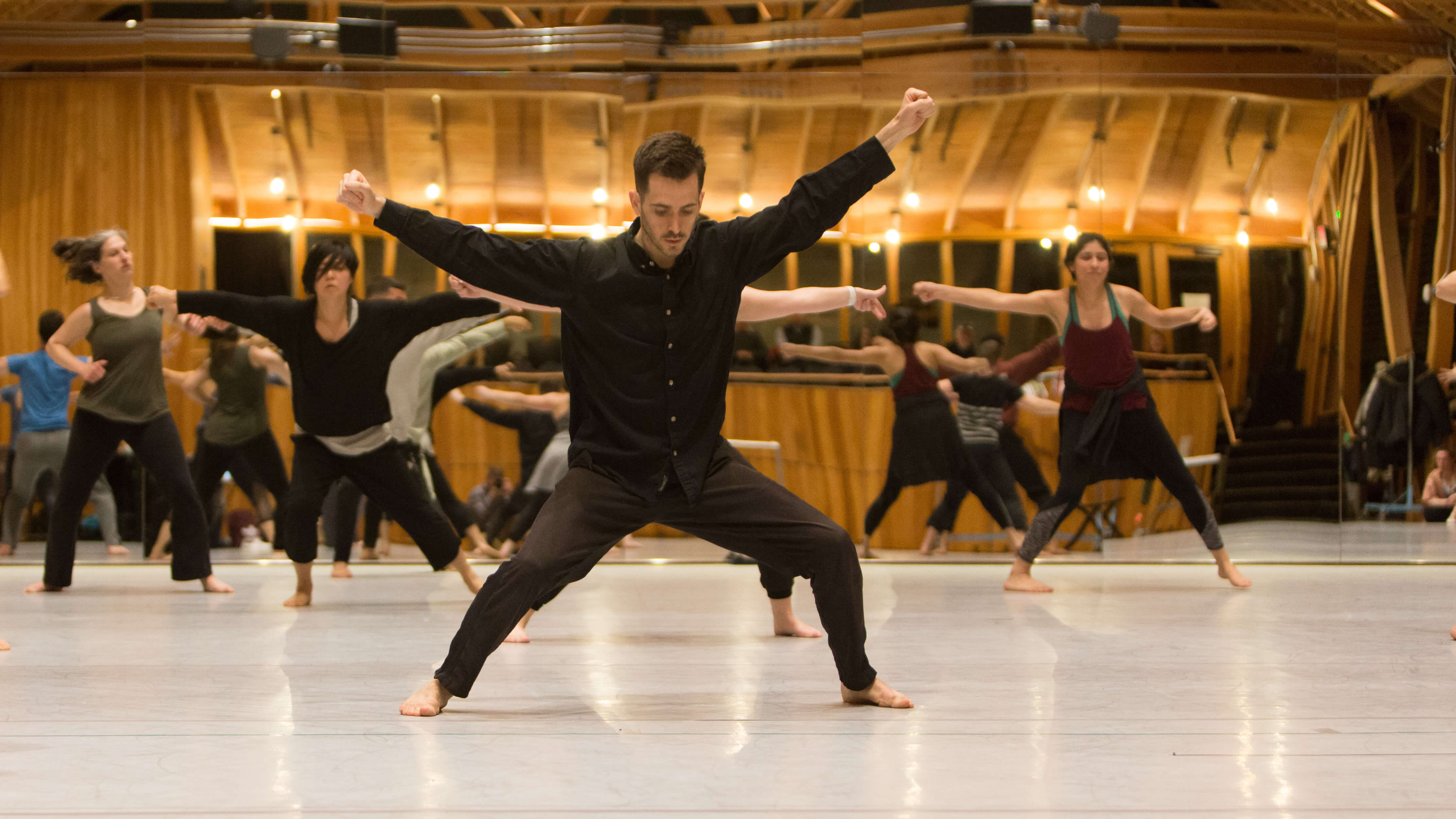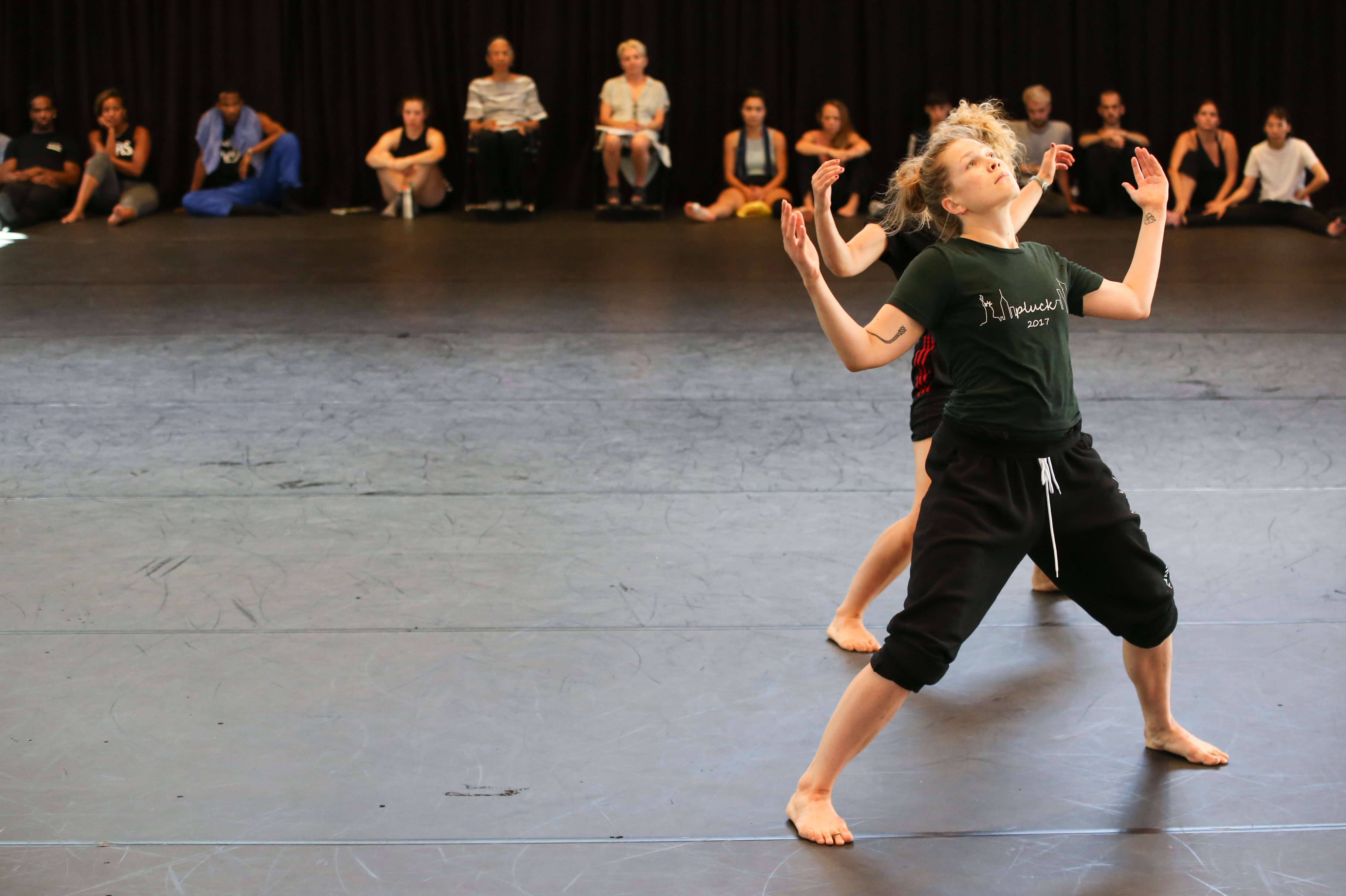
The Ann & Weston Hicks Choreography Fellows Program launched in the summer of 2018. Eight Hicks Choreography Fellows were selected for this fully process-oriented program which uses extensive studio time supplemented with discussions, assignments, and feedback sessions to craft and evolve choreography. Festival choreographers, guest choreographers, and other dance professionals met with the Fellows throughout the program to share career advice and address each choreographers’ individual questions.
We caught up with 2018 Hicks Choreography Fellow Russell Lepley in the winter of 2018, when he returned to work with his mentor Faye Driscoll during her Pillow Lab residency. Learn about his experience during the summer program under the direction of Program Directors Dianne McIntyre and Risa Steinberg, and gain insight into his post-program mentorship experience with Driscoll below.
What drew you to apply for program?
I first saw it in a newsletter at Ohio Dance and I recently started Flux Flow Dance Project about three months prior to seeing the application. It seemed like a good opportunity to expand my knowledge, to network, and to have an amazing opportunity in an amazing place. I had been to Jacob’s Pillow as a performer with Les Grands Ballets Canadiens many years ago.
What was your experience like during those 10 days?
Intense! The summer portion of the fellowship was very rich and we were given full access to all of Jacob’s Pillow’s resources. The resources are so robust that we were scheduled from morning to night with dance—and choreography—related programming. It was interesting to engage with the other choreographers, to bounce impressions off of works we watched together, and to be able to clarify your own identity and voice amidst a group of peers. My favorite part of the fellowship was the mentorship from Risa and Dianne. They had this way of making us all feel that we weren’t being taught how to choreograph, but instead how to refine the tool kit we were already working with. It allowed the experience to be really individualized for each choreographer rather than some kind of homogeneous experience.
“I have to say what it gave me was a lot of confidence and inspiration to take back to my community.”
Russell Lepley
2018 Hicks Choreography Fellow
One part of the program was to have talks with experts in various areas of the field. As a new choreographer you may be working without a lot of knowledge in things such as lighting, production, and costumes and how it relates to putting a work together. You may be more comfortable in the studio or on stage in certain contexts. Having these practical conversations was so insightful. We even learned about fundraising and someone spoke to us about the economics of how to make a dance company work. That was one of the things that was a direct takeaway for me. We started working on our first evening-length pieces as Flux Flow Dance Project at the Pillow and performed them in December. I had something concrete to raise money for and used the information I learned and reframed how we asked for money. As a choreographer there are all these other hats you have to wear and being able to speak to people who wear those hats allowed me to have more acceptance of that fact and inspiration.
“It’s all about relationship building and nurturing those relationships. There’s more to being a choreographer than creating interesting movement or creating dynamic performances.”
Russell Lepley
2018 Hicks Choreography Fellow
What did select Faye Driscoll as your mentor?
I wanted to expand my toolbox. My dance background is in classical ballet and then I transitioned into contemporary dance and did both of them professionally. Toward my last couple of years in the company that I was in, I had some experiences doing dance theater. I did a lot of theater growing up and I felt more complete as a performer in the genre-mixing elements. I found myself very interested in it and it was very clear to me that this was the kind of work I wanted to try to make. Faye has that kind of genre-bending aspect in her work. She’s working on a solo and there’s a lot of objects and materials. It’s a very serious piece, and she’s very serious about her Play, but there’s this kind of process where you start to realize that an object can almost be like a performer. It has its own energy and space which is something I have thought very little about, especially working with choreographers who use just human bodies. I chose Faye because I like that she’s pushing the boundaries of performance. It felt like a great opportunity to expand my toolbox and allow myself to be pushed outside of my comfort zone.
How is your experience now in the winter setting of Jacob’s Pillow?
I would say it’s like the moon compared to the sun. The summer was very full and intense, and this is very full but in a much more spacious way. The Pillow in the winter is beautiful and quiet and there’s more unstructured time which allows me to be a bit more lost in my thoughts and in my notebooks. It’s really nice to have this free time to spend with Faye and when I’m not with Faye, to be with my own ideas. Right now I’m preparing for a performance for when I get back. I have space to work toward that performance but having Faye beside that work is really interesting because it’s reinforcing the work that I’m making.
“It’s nice there’s a little less structure this time , but there’s still a lot of intensity because there are so many resources.”
Russell Lepley
2018 Hicks Choreography Fellow
In the Archives I watched some of Faye’s past work that I hadn’t seen because I’d only seen Thank You For Coming: Attendance. I watched Thank You For Coming: Play and today I was browsing for other pieces that have that genre-bending quality just to see what I could find.
What advice do you have for future Hicks Choreography Fellows?
The application has a lot of various elements and they’re really looking for a whole person. Take the time to give care and love to each part of your application Risa and Dianne spoke about this afterwards with us, what they looked for, and know that they’re not looking for a finished product. They’re looking for a person with integrity, conviction, and belief in what they’re making.
This program is not built as a residency to make your own work or for the time be all about your work. This program is about enriching you as a choreographer and artist, so come in with the desire to develop work with your dancers but also be receptive to the resources available here. It might feel overwhelming but all of the aspects of the program enrich you in a way that when you leave, all of those ideas you take in and absorb can be processed. Just come in with openness.
The Ann & Weston Hicks Choreography Fellows Program 2019
Immerse yourself in this 10-day experience & evolve your choreographic ideas under the direction of transformative dance artists & mentors Dianne McIntyre and Risa Steinberg.
Develop your artistic voice
Learn more about The Ann & Weston Hicks Choreography Fellows Program
